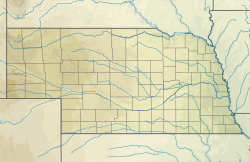| Virginia Smith Dam | |
|---|---|
 | |
| Country | United States |
| Location | Garfield County, Nebraska, United States. |
| Coordinates | 41°50′00″N99°12′00″W / 41.8333°N 99.2000°W |
| Status | Operational |
| Owner | U.S. Bureau of Reclamation |
| Dam and spillways | |
| Type of dam | Embankment |
| Impounds | Calamus River |
| Height | 96 ft (29 m) |
| Length | 5,808 ft (1,770 m) |
| Reservoir | |
| Creates | Calamus Reservoir |
| Total capacity | 27,400 acre⋅ft (33,797,402 m3) |
| Catchment area | 147 sq mi (381 km2) |
| Surface area | 5,123 acres (2,073 ha) |
| Maximum length | 10 mi (16 km) |
| Normal elevation | 2,244 ft (684 m) msl |
| Website U.S. Bureau of Reclamation, Virginia Smith Dam | |

Virginia Smith Dam (also known as Calamus Dam; National ID # NE02287) is a dam in Garfield County, Nebraska, about five miles northwest of Burwell.
The earthen dam was constructed in 1985 by the United States Bureau of Reclamation with a height of 96 feet (29 m) and 5,808 feet (1,770 m) long at its crest. [1] It impounds the Calamus River for irrigation storage and flood control, as part of the North Loup Division of the extensive, multi-state Pick–Sloan Missouri Basin Program. The dam is owned by the Bureau and is operated by the local Twin Loup Irrigation District. [2]
The reservoir it creates, Calamus Reservoir, has a water surface of 5,142 acres (2,081 ha), 6,404 acres (2,592 ha) of land, about 31 miles (50 km) of shoreline, and a maximum capacity of 27,400 acre-feet (33,800,000 m3). [3] Recreation includes fishing (walleye, wiper, white bass, northern pike, largemouth bass, rainbow trout, and crappie, etc.), hunting, boating, camping and hiking. [4] The reservoir is also the site of the state Calamus Reservoir State Recreation Area and Wildlife Management Area. Although the dam itself is located in Garfield County, most of the reservoir lies in Loup County, to its west.
The lake and surrounding public lands are a part of the Calamus State Recreation Area, managed by the Nebraska Game and Parks Commission.

